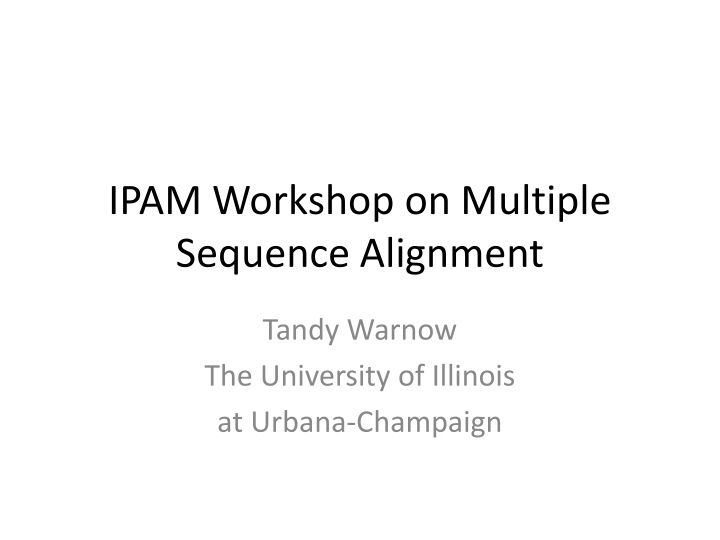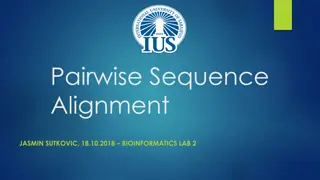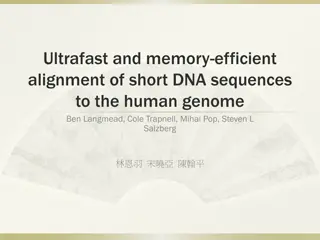Challenges and Techniques in Multiple Sequence Alignment
Multiple Sequence Alignment (MSA) poses a significant challenge due to NP-hard problems, large datasets, and the lack of accuracy in current methods. Novel techniques are needed to address scalability and accuracy issues in MSA, which serves multiple purposes like phylogeny estimation and structure prediction. The construction of the Tree of Life requires addressing hard computational problems related to big data complexity and errors in input data. Additionally, the phylogenomic pipeline involves selecting taxa, computing alignments, and estimating species trees with statistical support on each branch.
Download Presentation

Please find below an Image/Link to download the presentation.
The content on the website is provided AS IS for your information and personal use only. It may not be sold, licensed, or shared on other websites without obtaining consent from the author.If you encounter any issues during the download, it is possible that the publisher has removed the file from their server.
You are allowed to download the files provided on this website for personal or commercial use, subject to the condition that they are used lawfully. All files are the property of their respective owners.
The content on the website is provided AS IS for your information and personal use only. It may not be sold, licensed, or shared on other websites without obtaining consent from the author.
E N D
Presentation Transcript
IPAM Workshop on Multiple Sequence Alignment Tandy Warnow The University of Illinois at Urbana-Champaign
Multiple Sequence Alignment (MSA): a major grand challenge1 S1 = AGGCTATCACCTGACCTCCA S2 = TAGCTATCACGACCGC S3 = TAGCTGACCGC Sn = TCACGACCGACA S1 = -AGGCTATCACCTGACCTCCA S2 = TAG-CTATCAC--GACCGC-- S3 = TAG-CT-------GACCGC-- Sn = -------TCAC--GACCGACA Novel techniques needed for scalability and accuracy NP-hard problems and large datasets Current methods do not provide good accuracy Few methods can analyze even moderately large datasets Many important applications besides phylogenetic estimation 1 Frontiers in Massive Data Analysis, National Academies Press, 2013
Multiple Sequence Alignment Multiple purposes (e.g., phylogeny estimation and molecular function/structure prediction) Multiple techniques, drawing from disparate communities (biophysics, statistical inference, computer science, discrete mathematics, etc.) Multi-disciplinary effort and communication needed
Multiple Sequence Alignment Multiple purposes (e.g., phylogeny estimation and molecular function/structure prediction) Multiple techniques, drawing from disparate communities (biophysics, statistical inference, computer science, discrete mathematics, etc.) Multi-disciplinary effort and communication needed
Phylogeny (evolutionary tree) Orangutan Human Gorilla Chimpanzee From the Tree of the Life Website, University of Arizona
Constructing the Tree of Life: Hard Computational Problems NP-hard problems Large datasets 100,000+ sequences thousands of genes Big data complexity: model misspecification fragmentary sequences errors in input data streaming data
Phylogenomic pipeline Select taxon set and markers Gather and screen sequence data, possibly identify orthologs Compute multiple sequence alignments for each locus Compute species tree or network: Compute gene trees on the alignments and combine the estimated gene trees, OR Estimate a tree from a concatenation of the multiple sequence alignments Get statistical support on each branch (e.g., bootstrapping) Estimate dates on the nodes of the phylogeny Use species tree with branch support and dates to understand biology
Phylogenomic pipeline Select taxon set and markers Gather and screen sequence data, possibly identify orthologs Compute multiple sequence alignments for each locus Compute species tree or network: Compute gene trees on the alignments and combine the estimated gene trees, OR Estimate a tree from a concatenation of the multiple sequence alignments Get statistical support on each branch (e.g., bootstrapping) Estimate dates on the nodes of the phylogeny Use species tree with branch support and dates to understand biology
DNA Sequence Evolution -3 mil yrs AAGACTT AAGACTT -2 mil yrs AAGGCCT AAGGCCT AAGGCCT AAGGCCT TGGACTT TGGACTT TGGACTT TGGACTT -1 mil yrs AGGGCAT AGGGCAT AGGGCAT TAGCCCT TAGCCCT TAGCCCT AGCACTT AGCACTT AGCACTT today AGGGCAT AGGGCAT TAGCCCA TAGCCCA TAGACTT TAGACTT AGCACAA AGCACAA AGCGCTT AGCGCTT
Phylogeny Problem U V W X Y AGGGCAT TAGCCCA TAGACTT TGCACAA TGCGCTT X U Y V W
Performance criteria Running time Space Statistical performance issues (e.g., statistical consistency) with respect to a Markov model of evolution Topological accuracy with respect to the underlying true tree or true alignment, typically studied in simulation Accuracy with respect to a particular criterion (e.g. maximum likelihood score), on real data
Markov models of site evolution Simplest (Jukes-Cantor): The model tree is a pair (T,{e,p(e)}), where T is a rooted binary tree, and p(e) is the probability of a substitution on the edge e The state at the root is random If a site changes on an edge, it changes with equal probability to each of the remaining states The evolutionary process is Markovian More complex models (such as the General Markov model) are also considered, with little change to the theory.
Quantifying Error FN FN: false negative (missing edge) FP: false positive (incorrect edge) 50% error rate FP
Statistical consistency, exponential convergence, and absolute fast convergence (afc)
Phylogenetic reconstruction methods 1. Hill-climbing heuristics for hard optimization criteria (Maximum Parsimony and Maximum Likelihood) Local optimum Cost Global optimum Phylogenetic trees 2. Polynomial time distance-based methods: Neighbor Joining, FastME, Weighbor, etc. 3. Bayesian methods
Phylogeny Problem U V W X Y AGGGCAT TAGCCCA TAGACTT TGCACAA TGCGCTT X U Y V W
The real problem U V W X Y TAGACTT TGCACAA TGCGCTT AGGGCATGA AGAT X U Y V W
Indels (insertions and deletions) Deletion Mutation ACGGTGCAGTTACCA ACCAGTCACCA
Deletion Substitution ACGGTGCAGTTACCA Insertion ACGGTGCAGTTACC-A AC----CAGTCACCTA ACCAGTCACCTA The true multiple alignment Reflects historical substitution, insertion, and deletion events Defined using transitive closure of pairwise alignments computed on edges of the true tree
Input: unaligned sequences S1 = AGGCTATCACCTGACCTCCA S2 = TAGCTATCACGACCGC S3 = TAGCTGACCGC S4 = TCACGACCGACA
Phase 1: Alignment S1 = AGGCTATCACCTGACCTCCA S2 = TAGCTATCACGACCGC S3 = TAGCTGACCGC S4 = TCACGACCGACA S1 = -AGGCTATCACCTGACCTCCA S2 = TAG-CTATCAC--GACCGC-- S3 = TAG-CT-------GACCGC-- S4 = -------TCAC--GACCGACA
Phase 2: Construct tree S1 = AGGCTATCACCTGACCTCCA S2 = TAGCTATCACGACCGC S3 = TAGCTGACCGC S4 = TCACGACCGACA S1 = -AGGCTATCACCTGACCTCCA S2 = TAG-CTATCAC--GACCGC-- S3 = TAG-CT-------GACCGC-- S4 = -------TCAC--GACCGACA S1 S2 S3 S4
Simulation Studies S1 = AGGCTATCACCTGACCTCCA S2 = TAGCTATCACGACCGC S3 = TAGCTGACCGC S4 = TCACGACCGACA Unaligned Sequences S1 = -AGGCTATCACCTGACCTCCA S2 = TAG-CTATCAC--GACCGC-- S3 = TAG-CT-------GACCGC-- S4 = -------TCAC--GACCGACA S1 = -AGGCTATCACCTGACCTCCA S2 = TAG-CTATCAC--GACCGC-- S3 = TAG-C--T-----GACCGC-- S4 = T---C-A-CGACCGA----CA S1 S4 S1 S2 Compare S2 S3 S4 S3 True tree and alignment Estimated tree and alignment
Quantifying Error FN FN: false negative (missing edge) FP: false positive (incorrect edge) 50% error rate FP
Two-phase estimation Phylogeny methods Bayesian MCMC Maximum parsimony Maximum likelihood Neighbor joining FastME UPGMA Quartet puzzling Etc. Alignment methods Clustal POY (and POY*) Probcons (and Probtree) Probalign MAFFT Muscle Di-align T-Coffee Prank (PNAS 2005, Science 2008) Opal (ISMB and Bioinf. 2007) FSA (PLoS Comp. Bio. 2009) Infernal (Bioinf. 2009) Etc. RAxML: heuristic for large-scale ML optimization
Large-scale Alignment Estimation Alignments of large datasets with high rates of evolution typically have high error, and trees estimated on these alignments also have high error Only a few methods can analyze large datasets
1kp: Thousand Transcriptome Project T. Warnow, S. Mirarab, N. Nguyen, UIUC UT-Austin UT-Austin N. Matasci iPlant J. Leebens-Mack U Georgia N. Wickett Northwestern G. Ka-Shu Wong U Alberta Plus many many other people First study (Wickett, Mirarab, et al., PNAS 2014) had ~100 species and ~800 genes, gene trees and alignments estimated using SATe, and a coalescent-based species tree estimated using ASTRAL Second study: Plant Tree of Life based on transcriptomes of ~1200 species, and more than 13,000 gene families (most not single copy) Gene Tree Incongruence Upcoming Challenges: Species tree estimation from conflicting gene trees Alignment of datasets with > 100,000 sequences
1KP dataset: more than 100,000 p450 amino-acid sequences, many fragmentary Mean:317 Median:266 12000 10000 8000 Counts 6000 All standard multiple sequence alignment methods we tested performed poorly on datasets with fragments. 4000 2000 0 0 500 1000 1500 2000 Length
1kp: Thousand Transcriptome Project T. Warnow, S. Mirarab, N. Nguyen, UIUC UT-Austin UT-Austin N. Matasci iPlant J. Leebens-Mack U Georgia N. Wickett Northwestern G. Ka-Shu Wong U Alberta Plus many many other people First study (Wickett, Mirarab, et al., PNAS 2014) had ~100 species and ~800 genes, gene trees and alignments estimated using SATe, and a coalescent-based species tree estimated using ASTRAL Second study: Plant Tree of Life based on transcriptomes of ~1200 species, and more than 13,000 gene families (most not single copy) Gene Tree Incongruence Upcoming Challenges: Species tree estimation from conflicting gene trees Alignment of datasets with > 100,000 sequences, and many fragmentary sequences!
Multiple Sequence Alignment (MSA): another grand challenge1 S1 = AGGCTATCACCTGACCTCCA S2 = TAGCTATCACGACCGC S3 = TAGCTGACCGC Sn = TCACGACCGACA S1 = -AGGCTATCACCTGACCTCCA S2 = TAG-CTATCAC--GACCGC-- S3 = TAG-CT-------GACCGC-- Sn = -------TCAC--GACCGACA Novel techniques needed for scalability and accuracy NP-hard problems and large datasets Current methods do not provide good accuracy Few methods can analyze even moderately large datasets Many important applications besides phylogenetic estimation 1 Frontiers in Massive Data Analysis, National Academies Press, 2013
Phylogenomic pipeline Select taxon set and markers Gather and screen sequence data, possibly identify orthologs Compute multiple sequence alignments for each locus Compute species tree or network: Compute gene trees on the alignments and combine the estimated gene trees, OR Estimate a tree from a concatenation of the multiple sequence alignments Get statistical support on each branch (e.g., bootstrapping) Estimate dates on the nodes of the phylogeny Use species tree with branch support and dates to understand biology
Research Questions What are good statistical models of sequence evolution that include insertions, deletions, and other events (rearrangements, duplications, etc.)? Are the model trees identifiable under these models? Can we co-estimate sequence alignments and trees with high accuracy? Can we improve alignments? Can we do large-scale alignment estimation with high accuracy? Can we do alignment-free phylogeny estimation? How should we measure alignment accuracy? Are common ways of measuring alignment accuracy predictive of tree accuracy? Are alignments for the purpose of structure/function prediction the same as alignments for phylogeny estimation? What is the impact of alignment error on downstream biological analyses?
Research Questions What are good statistical models of sequence evolution that include insertions, deletions, and other events (rearrangements, duplications, etc.)? Are the model trees identifiable under these models? Can we co-estimate sequence alignments and trees with high accuracy? Can we improve alignments? Can we do large-scale alignment estimation with high accuracy? Can we do alignment-free phylogeny estimation? How should we measure alignment accuracy? Are common ways of measuring alignment accuracy predictive of tree accuracy? Are alignments for the purpose of structure/function prediction the same as alignments for phylogeny estimation? What is the impact of alignment error on downstream biological analyses?
Patsy Babbit Back to the Beginning: Which sequences to align? While much attention has been directed at mathematical and statistical issues for creating accurate multiple alignments, consideration of which sequences (or parts of sequences) and structures to align is less well explored. This issue is especially important for investigation of structure- function relationships in large sets of highly diverse homologs for which the proteins of unknown function are far greater than those that have been biochemically or structurally characterized. We discuss what we have learned about choosing representative sequences for creating MSAs from studies of several large and functionally diverse enzyme superfamilies and provide examples for how biologically informed questions can be framed using this context. Sequence similarity networks built to summarize on a large scale relationships among members of several of these superfamilies are used to illustrate new challenges for creating MSAs as the volume of sequence data continues to increase.
Alexandre Bouchard-Cote MSA using Divide-and-Conquer Sequential Monte Carlo Divide-and-Conquer Sequential Monte Carlo (D&C SMC), a method for performing inference on a collection of auxiliary distributions organized into a tree. D&C SMC provides a simple method for approximating the posterior distribution of Bayesian MSA models
Noah Daniels Structure-based multiple sequence alignments
Steve Evans Recovering a tree from the lengths of random subtrees Suppose that we sample the leaves of edge-weighted tree with n leaves in a uniform random order and record the lengths of the subtrees spanned by the first k leaves (that is, in biological terms, the phylogenetic diversity of the first k taxa) for k between 2 and n. ``Can we reconstruct the tree (up to isomorphism) from the joint probability distribution of this random increasing sequence of lengths?" The answer is affirmative if we know a priori that the tree belongs to one of a number of families, but the general question is still open.
Adam Godzik Analysis and multiple alignments of periodic proteins Periodic proteins, characterized by the presence of multiple repeats of short sequence motifs, present unique challenges in their analysis and alignments. Especially interesting class of periodic proteins are irregular periodic proteins, where individual repeats can vary in length, sometimes considerably. We have developed a series of tools to classify regularity (or irregularity) of periodic proteins and to use such irregularity patterns to guide the multiple alignments. We present application of these tools to a group of Leucine Rich Repeat (LRR) proteins.
Nick Grishin Pushing the limits of sequence profile similarity search and alignment Traditionally, sequence similarity search has been riding on negatives and deriving power from random models to be rejected for positive hits. Exploring the other side, we show that the search can be significantly improved by considering the positives, i.e., known homology relationships in a database of sequence profiles. Similar strategies have been widely used by most successful search engines, such as Google. This algorithm results in re-ranking of hits, but does not correct faulty alignments. The main focus in the sequence alignment field has been on alignment construction. However, many alignments are reasonably accurate with the exception of several mildly misaligned regions. We propose new approaches to refinement of existing alignments and show that successful a posteriori detection and correction of misaligned regions results in alignment improvement.
Jim Leebens-Mack Plant gene family circumscription, multiple sequence alignment, and phylogenomic analysis
Olivier Lichtarge Evolution versus disease: the calculus of life The relationship between genotype mutations and phenotype variations determines health in the short term and evolution over the long term, and it hinges on the action of mutations on fitness. A fundamental difficulty in determining this action, however, is that it depends on the unique context of each mutation, which is complex and often cryptic. As a result, the effect of most genome variations on molecular function and overall fitness remains unknown, and stands apart from population genetics theories linking fitness effect to polymorphism frequency. Here, we hypothesize that evolution is a continuous and differentiable physical process coupling genotype to phenotype. Thus elementary calculus and phylogenetics can be integrated into a perturbation analysis of the evolutionary relationship between genotype and phenotype that quantitatively links point mutations to function and fitness and that opens a new analytic framework for equations of biology. In practice, it explicitly bridges molecular evolution with population genetics with applications from protein redesign to the clinical assessment of human genetic variations.
Ari Loytyjoja Phylogeny-aware alignment with sequence graphs PAGAN is a new program for phylogeny-aware multiple sequence alignment using partial-order sequence graphs, and Wasabi is a graphical front-end for phylogeny-aware alignment. In PAGAN, we use sequence graphs to model uncertainties in character presence/absence and thus make the phylogeny-aware algorithm less sensitive to errors in guide phylogeny or noisy input data. PAGAN can also extend existing alignments with new data: we have built applications of this for phylogenetic placement of marker gene data and for reference-based scaffolding of NGS data.
Cedric Notredame Grabbing High Hanging Fruits From the Tree Of Life Results on simulated data suggest that some disagreements may exist between evolutionarily and structurally correct multiple sequence alignments I will introduce a recently developed confidence index for multiple sequence alignments, the TCS (Transitive consistency score) and show how this index can be used to both identify structurally correct positions in an alignment and evolutionary informative sites, thus suggesting more unity than initially thought between these two parameters. I will then introduce the structure based clustering method we recently developed to further test these hypothesis.
Jian Peng Distances between protein sequence alignments We consider the problem on how to measure the similarity between sequence alignments. With good similarity metrics, we are able to use machine learning methods to learn more accurate alignment models than traditional ones, for structure prediction and/or homology search.
Mark Ragan Phylogenetics without multiple sequence alignment Multiple alignment is computationally hard, and does not extend naturally to instances in which the sequences under consideration have been rearranged relative to each other, misassembled (or not assembled in the first place), or contain regions of lateral origin. I explore alternative approaches that begin with the extraction of short perfectly or near-perfectly matching character strings variously known as words, k-mers or n-grams. Using synthetic and empirical data I will survey the major alignment-free approaches in phylogenetics, consider their performance and robustness under various scenarios of sequence evolution, and comment on their computational scalability.
Benjamin Redelings Erasing Errors Due to Alignment Ambiguity When Estimating Positive Selection Current estimates of diversifying positive selection rely on first having an accurate multiple sequence alignment. Simulation studies have shown that under biologically plausible conditions, relying on a single estimate of the alignment from commonly used alignment software can lead to unacceptably high false positive rates in detecting diversifying positive selection. We present a novel statistical method that eliminates excess false positives resulting from alignment error by jointly estimating the degree of positive selection and the alignment under an evolutionary model. We also show that samples taken from the posterior alignment distribution using the software BAli-Phy have substantially lower alignment error compared to MUSCLE, MAFFT, PRANK, and FSA alignments.
Sebastien Roch Survey of theoretical results/questions on phylogeny reconstruction/alignment under TKF- type models.
Scott Schmidler The Cutoff Phenomenon in Evolutionary Models for Sequence Alignment We examine limits on inferring evolutionary divergence times using sequence evolution models arising as a consequence of the probabilistic cutoff phenomenon , in which a Markov chain remains far equilibrium for an extended period, followed by a rapid transition into equilibrium. We show that evolutionary sequence models exhibit a cutoff, which relates directly to increased uncertainty in evolutionary distance inferences. We derive the cutoff explicitly for symmetric models, and demonstrate empirically the behavior in models routinely used in the literature. We also show how to locate cutoffs for specific models and sequences. Finally, we show that the cutoff explains several previously reported problems with common default priors for Bayesian phylogenetic analysis, and we suggest a new class of priors to address these problems.
Martin Weigt Coevolutionary modeling of protein sequences: Inference of 3D structure and mutational landscapes Direct-Coupling Analysis (DCA): a statistical- inference approach for detecting direct residue coevolution in large multiple-sequence alignments of homologous proteins. predict tertiary and quaternary protein structures, reconstruct protein-protein interaction networks, and infer quantitative mutational landscapes.























